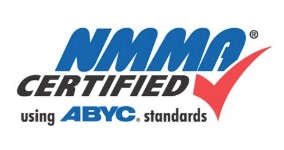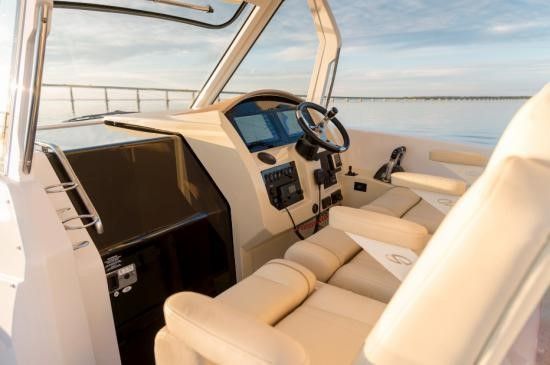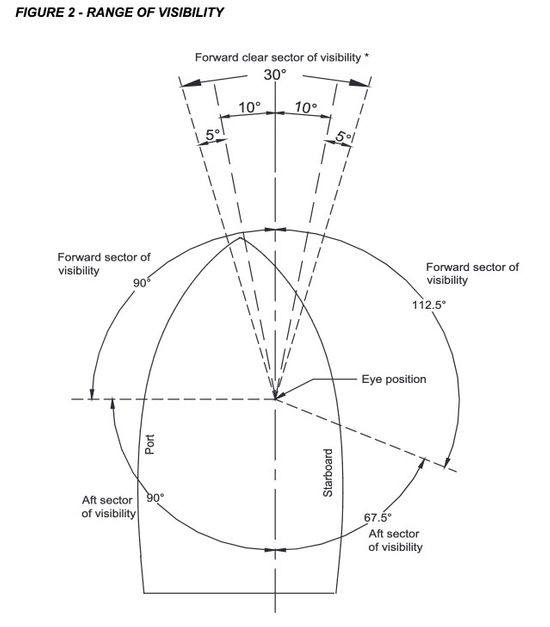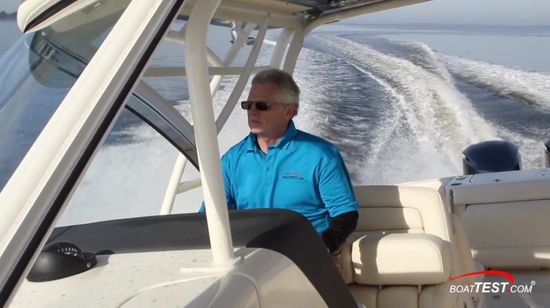Does Your Visibility from the Helm Pass ABYC Muster?


All powered vessels must give way to boats approaching from the starboard quadrant. (Rule 15 of the USCG Nav Rules). The trouble is, if an operator can’t see his forward starboard quadrant, there could be problems. There are quite specific ABYC standards regarding obstructions presented by permanently fixed equipment, hardtop supports, windshield mullions, overhead brows, and bulkheads. Does your boat conform to them?

Boat Building Standards:
Horizontal Field of Vision from the Helm Position
ABYC Standards--
Notes:
- This standard applies to all boats powered by machinery.
1. In order for this standard to be effective, the boat must be operated in a reasonable and prudent manner.
2. Boats can be operated in a manner and at certain speeds, causing trim and/or roll angles such that vision is obscured. A boat operator may experience some loss of vision from the helm position while operating at high trim angles during the transition between displacement and planing mode.
3. This standard does not relieve the operator of the requirement to comply with the USCG Navigation Rules.
4. Movable items such as persons, gear, and convertible tops are considered under the control of the boat operator and therefore are not obstructions to visibility for the purpose of this standard.
EXCEPTION: Sailboats.
Definitions
- Aft Sector of Visibility - the aft horizontal arc measured between 90 degrees to port from straight astern and 67.5 degrees to starboard from straight astern.
- Forward Sector of Visibility - the forward horizontal arc measured between 90 degrees to port from straight ahead and 112.5 degrees to starboard from straight ahead.

- Length Overall (LOA) - the straight-line horizontal measurement from the foremost part of the boat to the aftmost part of the boat, measured parallel to the centerline and to the waterline. Attached pulpits, rudders, outboard engine brackets, handles, railings and other similarly attached extensions are not included in the measurement. Integrally formed, molded, or welded components and appendages, such as bow pulpits, swim platforms, attachment structures for the propulsion systems, and structural rub rails installed by the builder are included in the length.
- Ready-for-use condition - craft fully equipped for the intended use, including: fuel and water tanks filled. the weights for outboard engines and batteries at the highest rating for which the boat is intended to be equipped and operated.
REQUIREMENTS
- The visibility requirements shall be met with the boat in a ready-for-use condition.
- At least one helm station shall comply with this standard (ABYC H-1, Field of Vision from the Helm Position).
- Additional helm stations that do not comply with the requirements shall display a compliant label.
NOTE: An example of such a label follows.
- If a helm station is equipped with a seat and the station can comply with the requirements of H-1 from only the standing position, a label that complies with H-1.5.11 shall be displayed at the helm station.
WARNING
Visibility from this helm station is limited.
Avoid serious injury or death from collisions.
Maintain lookout as required by USCG Navigation Rules.
Read owner’s manual.
NOTE: An example of such a label follows.
WARNING
Visibility from the seated position at this helm station is limited.
Operation from a standing position may be necessary.
Avoid serious injury or death from collisions.
Maintain a lookout as required by USCG Navigation Rules.
Read owner’s manual.
- Controls for steering, shift, throttle and trim shall be positioned so that during use, operator hand contact can be maintained without movement of the operator’s eye below the eye position(s) for which the boat is designed. If a boat is designed to be operated from both a standing and a seated position this requirement shall be met from each position.
- Permanent tops and/or other boat structure in the vicinity of the operator shall not prevent the achievement of the visibility requirements.
NOTE: Readily removable obstructions to vision, such as convertible or camper tops, aft and side cockpit curtains, are not considered permanent structure. It is assumed that when these items are in place, caution in operation will be exercised and the operator will maintain a lookout as required by the USCG Navigation Rules.
- Windshield or windscreen glazing materials shall be in accordance with ABYC H-3, Exterior Windows, Windshields, Hatches, Doors, Port Lights, and Glazing Materials.
- Trim tabs and/or power trim, if standard equipment, may be used to meet the visibility requirements if used in accordance with the manufacturer’s instructions.
- If the use of trim tabs and/or power trim is necessary to meet the visibility requirements, instructions for the proper use of this equipment shall be included in the owner’s manual(s).

HORIZONTAL RANGE OF VISIBILITY IN THE FORWARD SECTOR
- Directly in front of the operator a center field of visibility of at least 30 degrees shall be provided that extends throughout the vertical range of visibility described in H-1.8.1 and extends horizontally from straight ahead at least 15 degrees to the left and at least 15 degrees to the right. (See FIGURE 2)
- Fixed obstructions to vision within this area shall be such that clear vision can be maintained.
NOTE: Appendix provides a means to comply with this requirement.
- The sectors from 0 degrees to 10 degrees port and starboard shall maintain clear vision without movement of the head in any direction.
- The sectors from 10 degrees to 15 degrees port and starboard sector shall maintain clear vision while allowing head movement of the operator of a maximum of 1.4 inches (35 mm) in either horizontal direction.
NOTES:
- Obstructions to visibility shall not overlap when viewed from the eye positions.
- Outside the clear sector of visibility throughout the horizontal arc measured from 90 degrees to port and 112.5 degrees to starboard, obstructions shall be kept to a minimum such that normal movements of the operator’s head will permit unobstructed visibility.
1. The clear vision is established using binocular vision (two eyes).
2. If the clear vision is determined by computational means, the maximum distance between eyes is taken as 2.25" (57.2 mm) apart.
HORIZONTAL RANGE OF VISIBILITY IN THE AFT SECTOR
- If permanent obstructions to vision exist in the aft sector of visibility, unobstructed visibility shall be provided by normal movement of the operator while maintaining control of the boat; or mirrors; or other means.
- The requirements shall be met from the seated position on boats designed for seated operation only; or the standing position on boats designed for standing operation only; or both the seated and standing positions if the vessel can be operated from either position, or if the boat can be operated from both the seated and standing position, but can only meet the standard from the standing position, then the helm station shall be labeled to indicate that visibility from the seated position is limited.
- The aft sector of visibility distance shall be measured with the boat in the static floating position.
- The standing eye position shall be established along a vertical line that is directly behind the center of the steering wheel and 16 inches aft of the center of the plane of the steering wheel rim.
